2008 TOYOTA HIGHLANDER HYBRID traction control
[x] Cancel search: traction controlPage 26 of 580
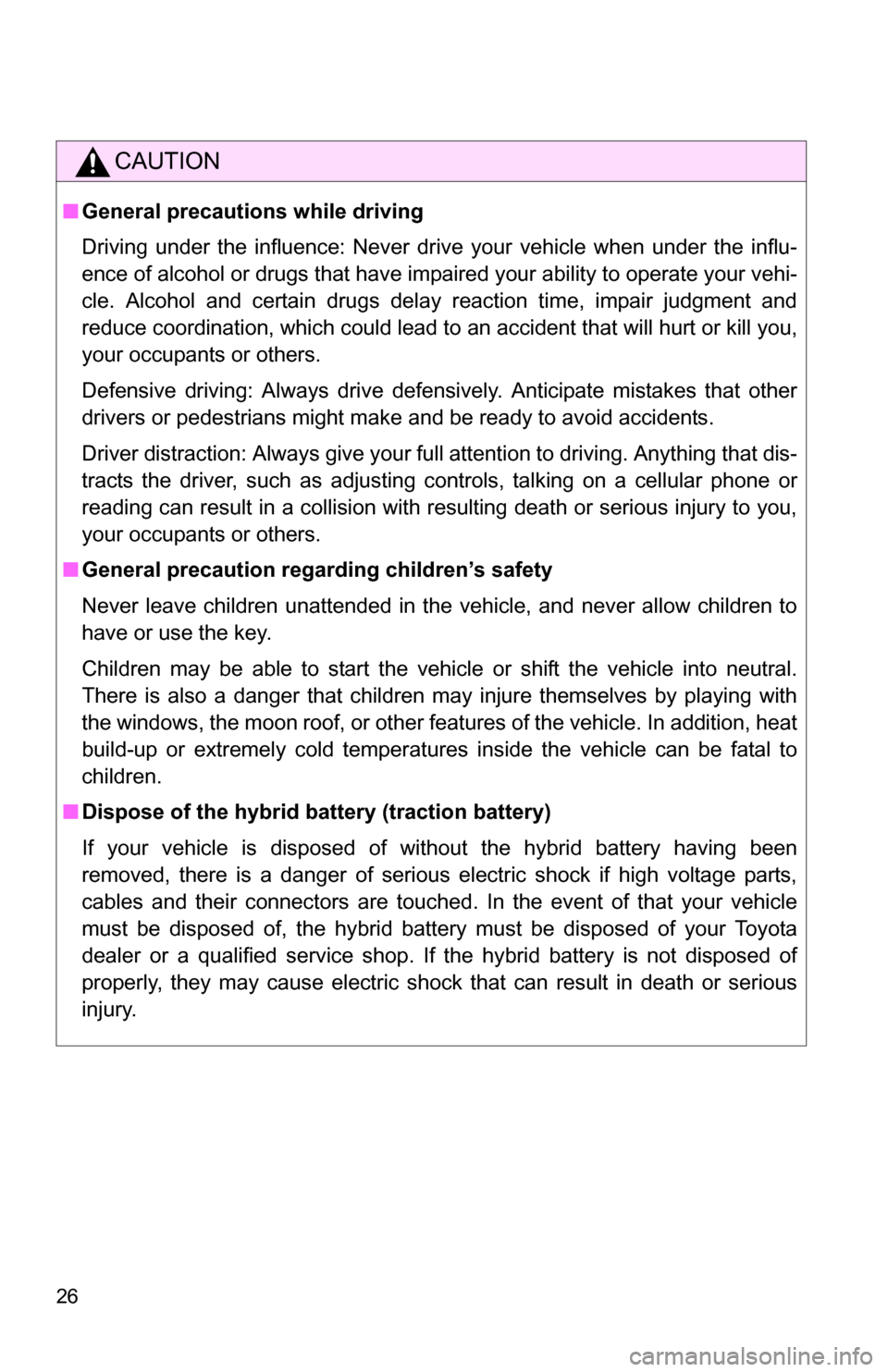
26
CAUTION
■General precautions while driving
Driving under the influence: Never drive your vehicle when under the influ-
ence of alcohol or drugs that have impaired your ability to operate your vehi-
cle. Alcohol and certain drugs delay reaction time, impair judgment and
reduce coordination, which could lead to an accident that will hurt or kill you,
your occupants or others.
Defensive driving: Always drive defensively. Anticipate mistakes that other
drivers or pedestrians might make and be ready to avoid accidents.
Driver distraction: Always give your full attention to driving. Anything that dis-
tracts the driver, such as adjusting controls, talking on a cellular phone or
reading can result in a collision with resulting death or serious injury to you,
your occupants or others.
■ General precaution regarding children’s safety
Never leave children unattended in the vehicle, and never allow children to
have or use the key.
Children may be able to start the vehicle or shift the vehicle into neutral.
There is also a danger that children may injure themselves by playing with
the windows, the moon roof, or other features of the vehicle. In addition, heat
build-up or extremely cold temperatures inside the vehicle can be fatal to
children.
■ Dispose of the hybrid battery (traction battery)
If your vehicle is disposed of without the hybrid battery having been
removed, there is a danger of serious electric shock if high voltage parts,
cables and their connectors are touched. In the event of that your vehicle
must be disposed of, the hybrid battery must be disposed of your Toyota
dealer or a qualified service shop. If the hybrid battery is not disposed of
properly, they may cause electric shock that can result in death or serious
injury.
Page 33 of 580
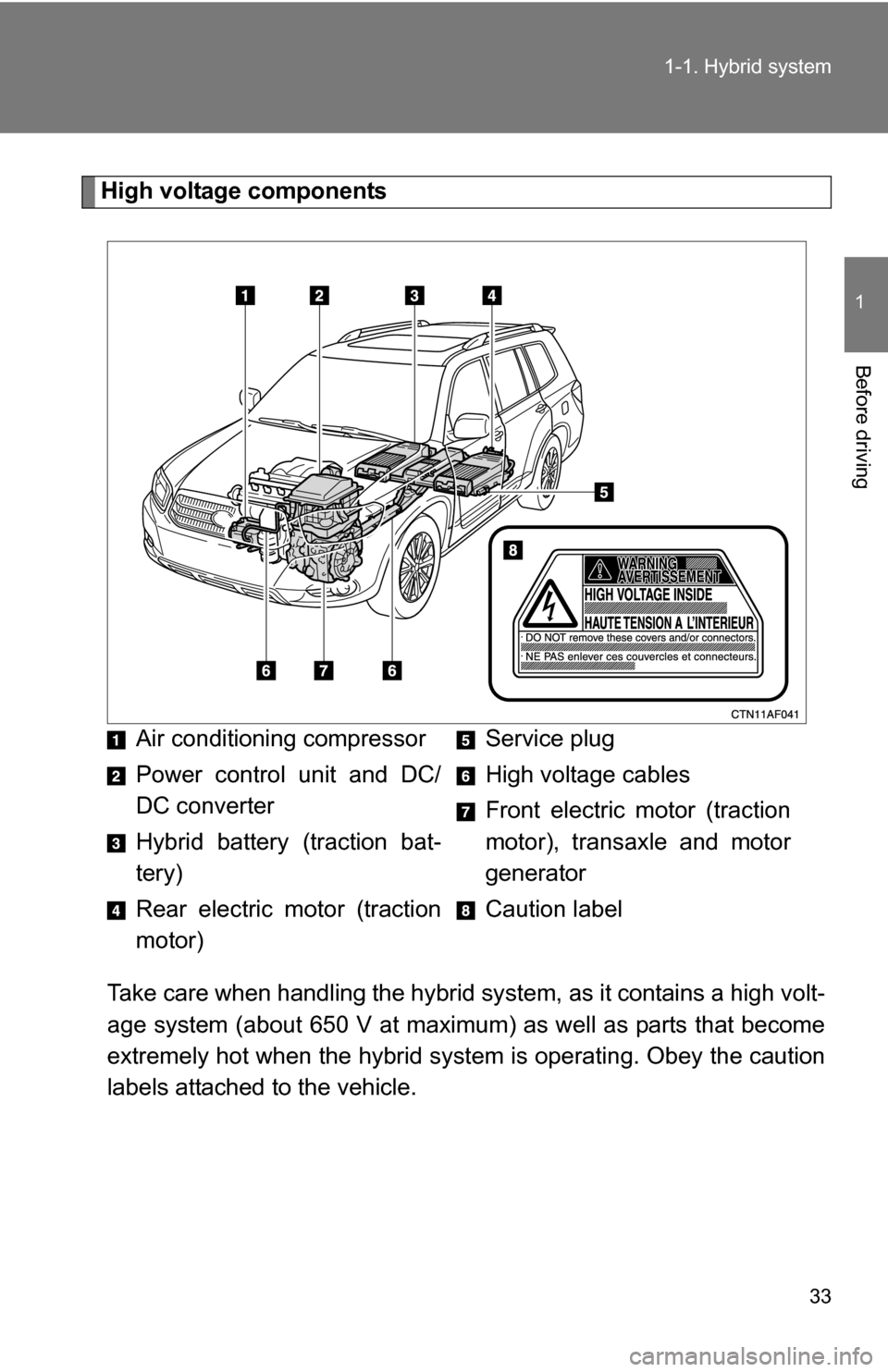
33
1-1. Hybrid system
1
Before driving
High voltage components
Take care when handling the hybrid sy stem, as it contains a high volt-
age system (about 650 V at maximum) as well as parts that become
extremely hot when the hybrid system is operating. Obey the caution
labels attached to the vehicle. Air conditioning compressor
Power control unit and DC/
DC converter
Hybrid battery (traction bat-
tery)
Rear electric motor (traction
motor)
Service plug
High voltage cables
Front electric motor (traction
motor), transaxle and motor
generator
Caution label
Page 168 of 580
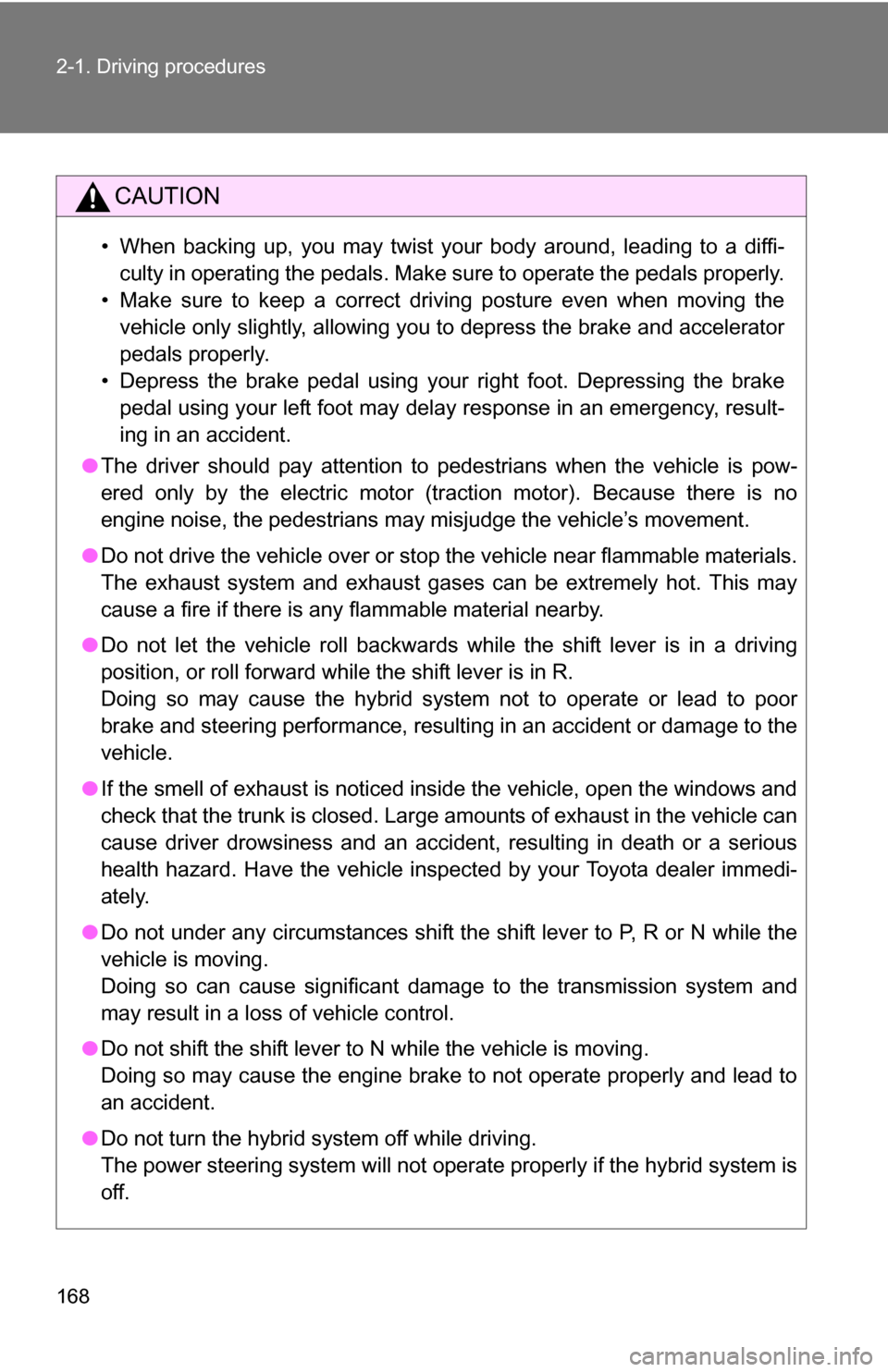
168 2-1. Driving procedures
CAUTION
• When backing up, you may twist your body around, leading to a diffi-culty in operating the pedals. Make sure to operate the pedals properly.
• Make sure to keep a correct driving posture even when moving the vehicle only slightly, allowing you to depress the brake and accelerator
pedals properly.
• Depress the brake pedal using your right foot. Depressing the brake pedal using your left foot may delay response in an emergency, result-
ing in an accident.
● The driver should pay attention to pedestrians when the vehicle is pow-
ered only by the electric motor (traction motor). Because there is no
engine noise, the pedestrians may misjudge the vehicle’s movement.
● Do not drive the vehicle over or st op the vehicle near flammable materials.
The exhaust system and exhaust gases can be extremely hot. This may
cause a fire if there is any flammable material nearby.
● Do not let the vehicle roll backwards while the shift lever is in a driving
position, or roll forward while the shift lever is in R.
Doing so may cause the hybrid system not to operate or lead to poor
brake and steering performance, resulting in an accident or damage to the
vehicle.
● If the smell of exhaust is noticed inside the vehicle, open the windows and
check that the trunk is closed. Large amounts of exhaust in the vehicle can
cause driver drowsiness and an accident, resulting in death or a serious
health hazard. Have the vehicle inspected by your Toyota dealer immedi-
ately.
● Do not under any circumstances shift the shift lever to P, R or N while the
vehicle is moving.
Doing so can cause significant damage to the transmission system and
may result in a loss of vehicle control.
● Do not shift the shift lever to N while the vehicle is moving.
Doing so may cause the engine brake to not operate properly and lead to
an accident.
● Do not turn the hybrid system off while driving.
The power steering system will not operate properly if the hybrid system is
off.
Page 215 of 580
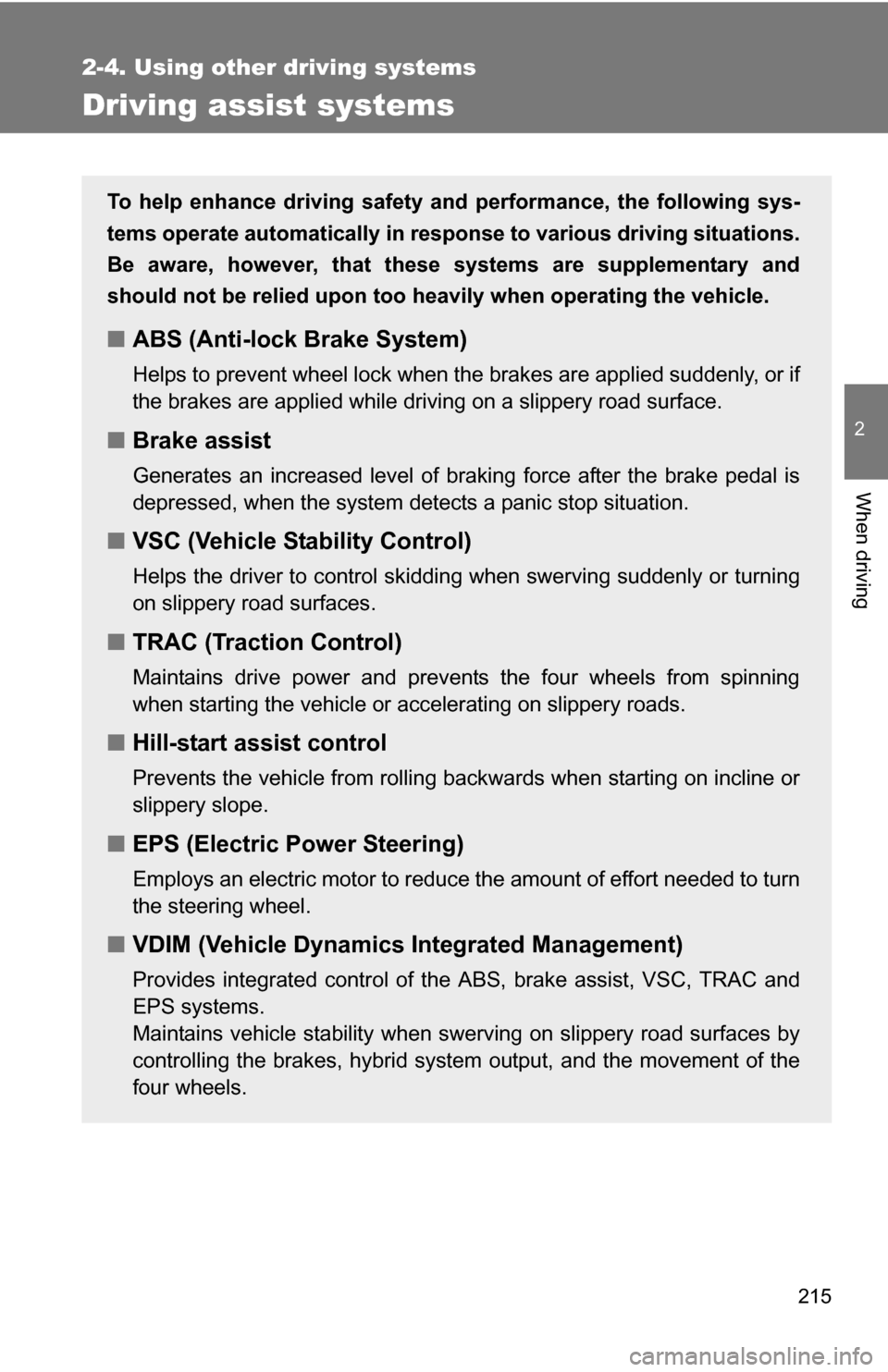
215
2-4. Using other driving systems
2
When driving
Driving assist systems
To help enhance driving safety and performance, the following sys-
tems operate automatically in res ponse to various driving situations.
Be aware, however, that these systems are supplementary and
should not be relied upon too heavi ly when operating the vehicle.
■ABS (Anti-lock Brake System)
Helps to prevent wheel lock when the brakes are applied suddenly, or if
the brakes are applied while driving on a slippery road surface.
■Brake assist
Generates an increased level of braking force after the brake pedal is
depressed, when the system detects a panic stop situation.
■VSC (Vehicle Stability Control)
Helps the driver to control skidding when swerving suddenly or turning
on slippery road surfaces.
■TRAC (Traction Control)
Maintains drive power and prevents the four wheels from spinning
when starting the vehicle or accelerating on slippery roads.
■Hill-start assist control
Prevents the vehicle from rolling backwards when starting on incline or
slippery slope.
■EPS (Electric Power Steering)
Employs an electric motor to reduce the amount of effort needed to turn
the steering wheel.
■VDIM (Vehicle Dynamics Integrated Management)
Provides integrated control of the ABS, brake assist, VSC, TRAC and
EPS systems.
Maintains vehicle stability when swerving on slippery road surfaces by
controlling the brakes, hybrid system output, and the movement of the
four wheels.
Page 467 of 580
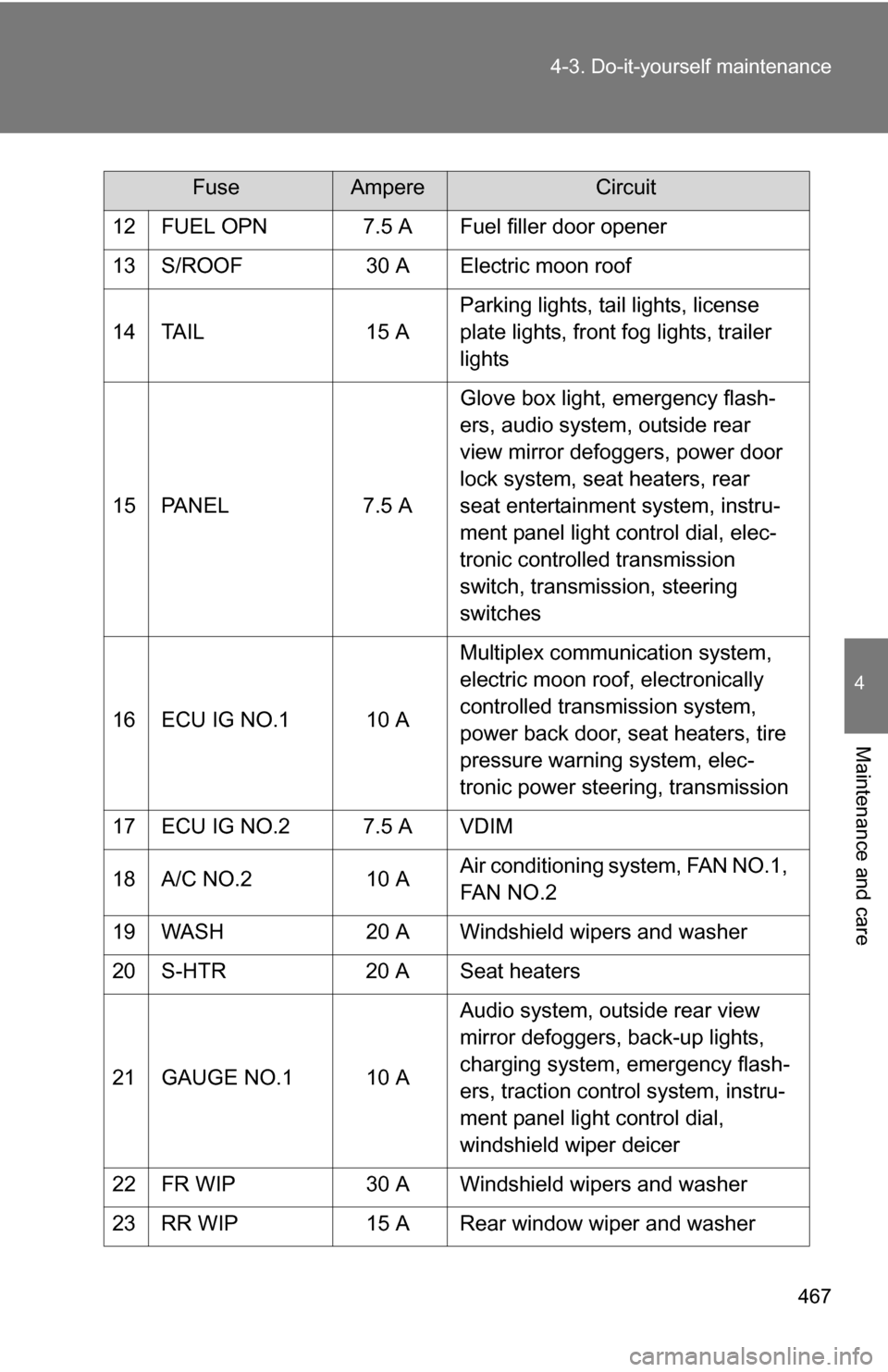
467
4-3. Do-it-yourself maintenance
4
Maintenance and care
12 FUEL OPN 7.5 A Fuel filler door opener
13 S/ROOF 30 A Electric moon roof
14 TAIL 15 A
Parking lights, tail lights, license
plate lights, front fog lights, trailer
lights
15 PANEL 7.5 A Glove box light, emergency flash-
ers, audio system, outside rear
view mirror defoggers, power door
lock system, seat heaters, rear
seat entertainment system, instru-
ment panel light control dial, elec-
tronic controlled transmission
switch, transmission, steering
switches
16 ECU IG NO.1 10 A Multiplex communication system,
electric moon roof, electronically
controlled transmission system,
power back door, seat heaters, tire
pressure warning system, elec-
tronic power steering, transmission
17 ECU IG NO.2 7.5 A VDIM
18 A/C NO.2 10 A Air conditioning system, FAN NO.1,
FAN NO.2
19 WASH 20 A Windshield wipers and washer
20 S-HTR 20 A Seat heaters
21 GAUGE NO.1 10 A Audio system, outside rear view
mirror defoggers, back-up lights,
charging system, emergency flash-
ers, traction control system, instru-
ment panel light control dial,
windshield wiper deicer
22 FR WIP 30 A Windshield wipers and washer
23 RR WIP 15 A Rear window wiper and washer
FuseAmpereCircuit
Page 552 of 580

552 6-1. Specifications
■Treadwear
The treadwear grade is a comparative rating based on the wear
rate of the tire when tested under controlled conditions on a speci-
fied government test course.
For example, a tire graded 150 would wear one and a half (1 - 1/2)
times as well on the government course as a tire graded 100.
The relative performance of tires depends upon the actual conditions
of their use, however, and may depart significantly from the norm due
to variations in driving habits, service practices and differences in
road characteristics and climate.
■ Traction AA, A, B, C
The traction grades, from highest to lowest, are AA, A, B and C,
and they represen t the tire's ability to stop on wet pavement as
measured under controlled cond itions on specified government
test surfaces of asphalt and concrete.
A tire marked C may have poor traction performance.
Warning: The traction grade assigned to this tire is based on braking
(straight ahead) traction tests and does not include cornering (turn-
ing) traction.
■ Temperature A, B, C
The temperature grades are A (the highest), B, and C, represent-
ing the tire's resistance to the generation of heat and its ability to
dissipate heat when tested under controlled conditions on a speci-
fied indoor laboratory test wheel.
Sustained high temperature can cause the material of the tire to
degenerate and reduce tire life, and excessive temperature can lead
to sudden tire failure.
The grade C corresponds to a level of performance which all passen-
ger car tires must meet under the Federal Motor Vehicle Safety Stan-
dard No. 109.
Grades B and A represent higher levels of performance on the labo-
ratory test wheel than the minimum required by law.
Page 566 of 580
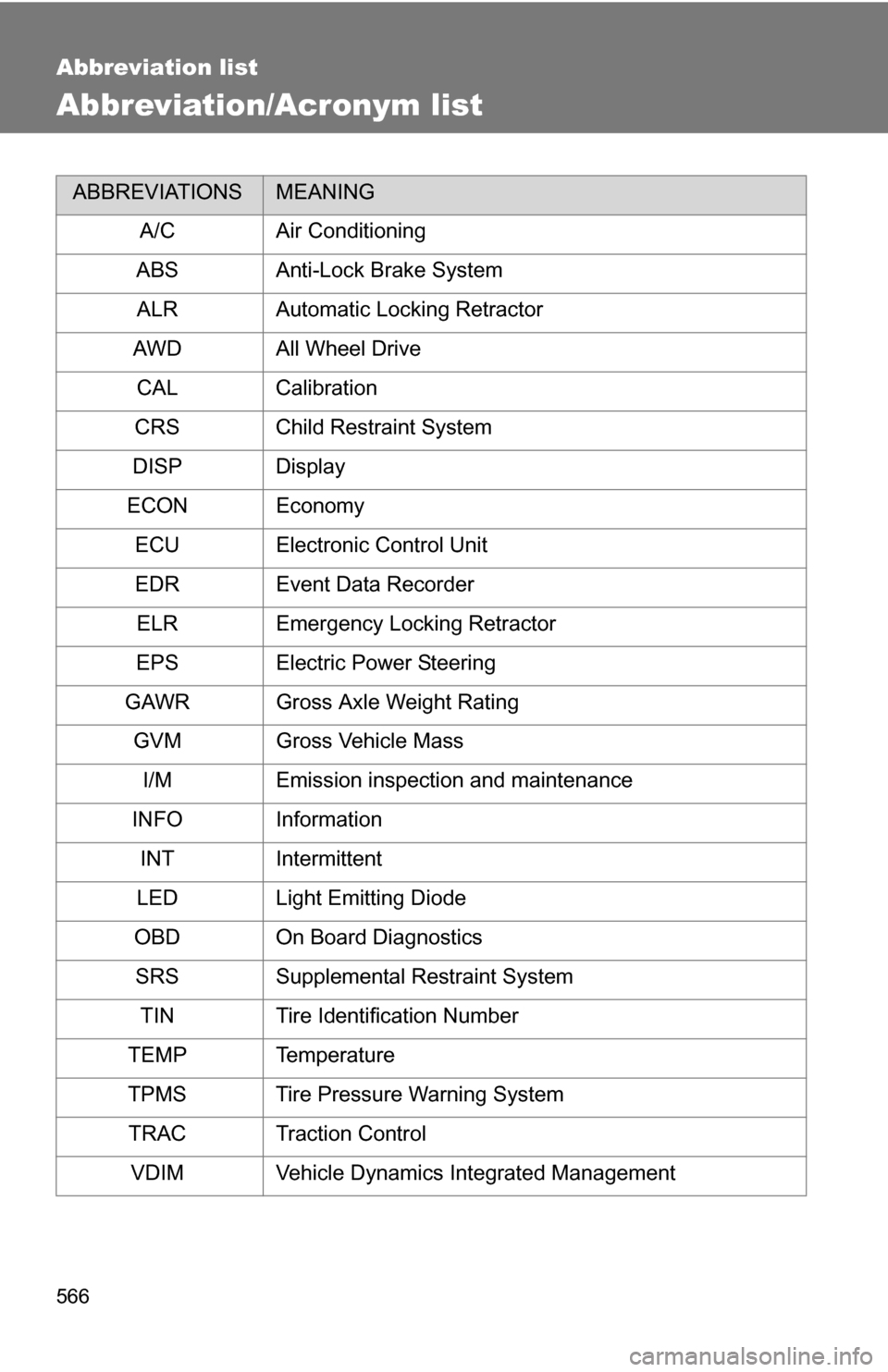
566
Abbreviation list
Abbreviation/Acronym list
ABBREVIATIONSMEANING
A/C Air Conditioning
ABS Anti-Lock Brake System ALR Automatic Locking Retractor
AWD All Wheel Drive CAL Calibration
CRS Child Restraint System
DISP Display
ECON Economy ECU Electronic Control Unit
EDR Event Data Recorder
ELR Emergency Locking Retractor
EPS Electric Power Steering
GAWR Gross Axle Weight Rating
GVM Gross Vehicle Mass I/M Emission inspection and maintenance
INFO Information
INT Intermittent
LED Light Emitting Diode
OBD On Board Diagnostics
SRS Supplemental Restraint System TIN Tire Identification Number
TEMP Temperature
TPMS Tire Pressure Warning System
TRAC Traction Control VDIM Vehicle Dynamics Integrated Management
Page 568 of 580
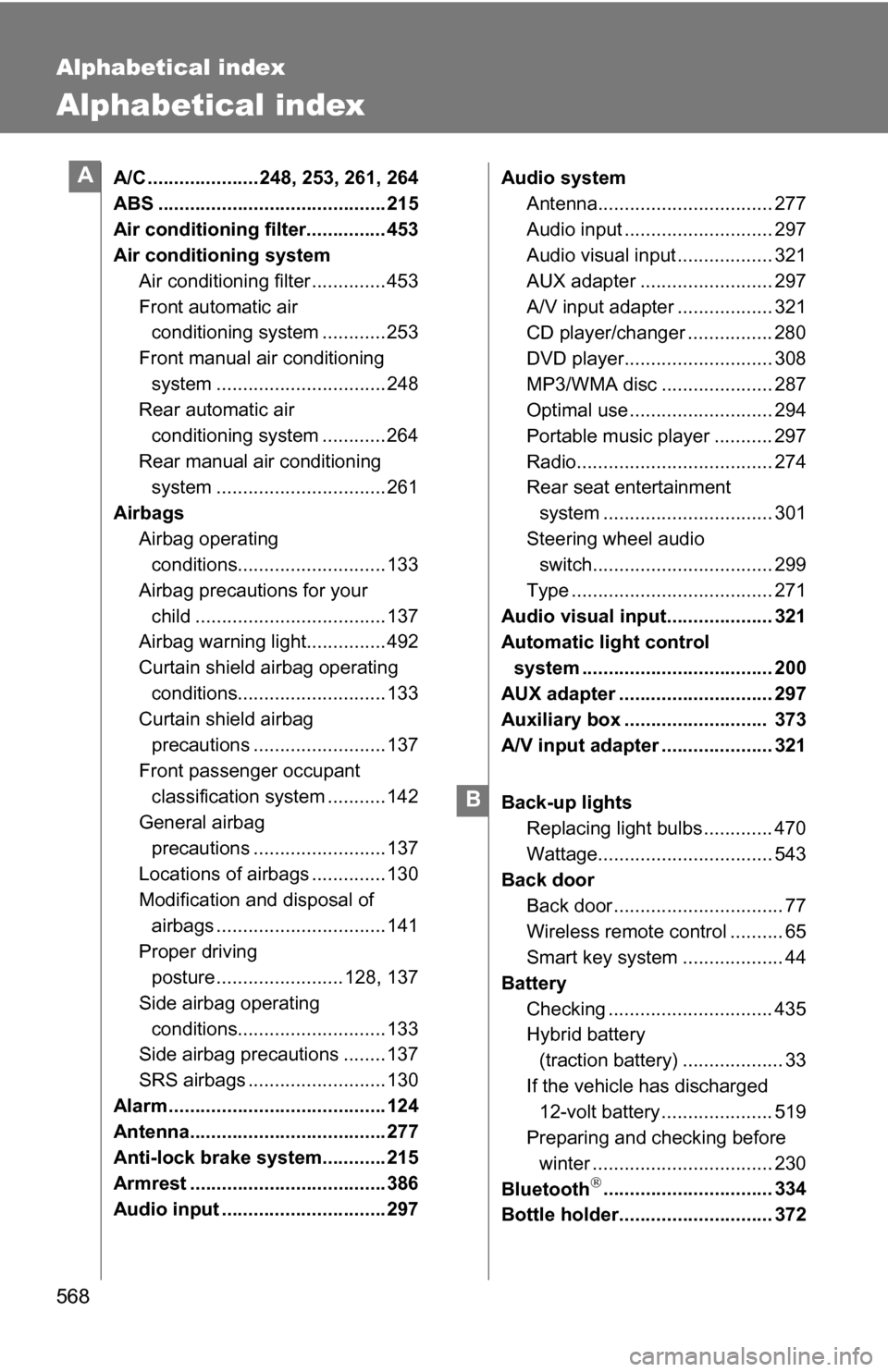
568
Alphabetical index
Alphabetical index
A/C ..................... 248, 253, 261, 264
ABS ........................................... 215
Air conditioning filter............... 453
Air conditioning systemAir conditioning filter .............. 453
Front automatic air conditioning system ............ 253
Front manual air conditioning system ................................ 248
Rear automatic air
conditioning system ............ 264
Rear manual air conditioning system ................................ 261
Airbags Airbag operating conditions............................ 133
Airbag precautions for your child .................................... 137
Airbag warning light............... 492
Curtain shield airbag operating
conditions............................ 133
Curtain shield airbag
precautions ......................... 137
Front passenger occupant classification system ........... 142
General airbag precautions ......................... 137
Locations of airbags .............. 130
Modification and disposal of
airbags ................................ 141
Proper driving
posture ........................ 128, 137
Side airbag operating conditions............................ 133
Side airbag precautions ........ 137
SRS airbags .......................... 130
Alarm ......................................... 124
Antenna..................................... 277
Anti-lock brake system............ 215
Armrest ..................................... 386
Audio input ............................... 297 Audio system
Antenna................................. 277
Audio input ............................ 297
Audio visual input .................. 321
AUX adapter ......................... 297
A/V input adapter .................. 321
CD player/changer ................ 280
DVD player............................ 308
MP3/WMA disc ..................... 287
Optimal use ........................... 294
Portable music player ........... 297
Radio..................................... 274
Rear seat entertainment system ................................ 301
Steering wheel audio switch.................................. 299
Type ...................................... 271
Audio visual input.................... 321
Automatic light control system .................................... 200
AUX adapter ............................. 297
Auxiliary box ........................... 373
A/V input adapter ..................... 321
Back-up lights Replacing light bulbs ............. 470
Wattage................................. 543
Back door Back door ................................ 77
Wireless remote control .......... 65
Smart key system .. ................. 44
Battery Checking ............................... 435
Hybrid battery (traction battery) ................... 33
If the vehicle has discharged 12-volt battery ..................... 519
Preparing and checking before winter .................................. 230
Bluetooth
................................ 334
Bottle holder............................. 372
A
B